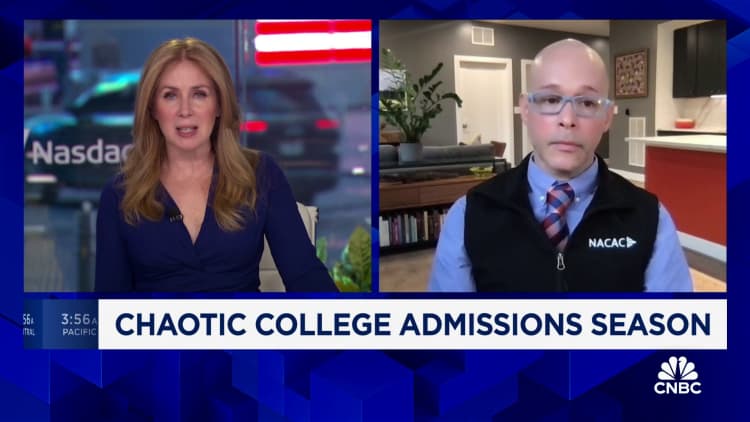Jamie Grill | Getty Images
It may not be the season’s new hot toy, but gifting a child money toward college could have a more lasting impact.
Daniel Trujillo, 39, a certified public accountant in Albuquerque, New Mexico, said he was blown away when his friend suggested putting money into a college savings account in lieu of a gift for his son Teo’s birthday.
“When my son turned 2, one of my friends made a contribution to the 529 instead of a present,” Trujillo said. “I thought that was pretty darn cool.”
‘It’s going to take a village’
As overall participation rates in 529 college savings plans have been rising, so too are gifts from friends and family.
Altogether, total investments in 529 plans jumped to $450.5 billion as of June, up nearly 10% from $412.5 billion the year before, according to data from the College Savings Plans Network, a network of state-administered college savings programs.
Of the $6.94 billion in contributions in the most recent quarter, roughly 5.4%, or $372.6 million, came from plan gifting platforms.
“We are seeing an increase in gifts of all sizes with an average of $100 from friends and extended family for a child they love,” said Wayne Weber, CEO of Gift of College, a gifting platform for higher education and workplace benefits.
More from Personal Finance:
Nearly half of student loan borrowers expect debt forgiveness
The best private and public colleges for financial aid
More of the nation’s top colleges roll out no-loan policies
“People are more willing to reach out to family and friends so the child is not burdened with student loans,” said Chris McGee, chair of the College Savings Foundation, a nonprofit that provides public policy support for 529 plans.
In 2023, 45% of parents said they would ask a family or friend to make a contribution. In 2024, that percentage jumped to 65%, according to the College Savings Foundation’s State of Higher Ed Savings survey.
“It’s the realization that it’s going to take a village to afford higher education,” McGee said.
Financial experts and plan investors agree that 529 plans are a smart choice for many.
As of 2024, 74% of parents surveyed have started making regular contributions to a 529, according to Fidelity’s College Savings Indicator — a spike from 58% in 2007, when the study was first conducted. Fidelity polled nearly 2,000 families with children high school age and younger between April and May.
And yet, only 30% are on track to hit their college savings goals, Fidelity also found.
Gifting can help narrow the gap, according to Jordan Lee, the CEO of Saving for College and Backer, a San Francisco-based company focused on making 529 plans more accessible.
Even small contributions will compound over the years, he added, and can serve as “a great way to stay involved and help a kid with their future in a meaningful way.”
The average size of a monthly gift is roughly $65, while one-time gifts average $370, according to data provided by Backer.
“That can be super significant depending on how actively you promote the opportunity to friends and relatives,” Lee said.
How to ask for college savings gifts
Lee suggests checking whether your plan has a gifting platform, with a link or code that can be sent to friends and family. Otherwise, you can set up a personalized gift page through an app like Backer and share the link with your loved ones ahead of holidays, birthday parties, graduation ceremonies or even on a baby shower.
“It’s kind of a no-pressure way to invite people to contribute,” Lee said.
If family members are reluctant to forgo the fun of a wrapped present, Lee suggests splitting the difference.
“There’s some hesitation sometimes but it’s not either/or — give a physical book or toy and set up a contribution,” Lee said.
According to Fidelity’s most recent data, 79% of parents say they would welcome contributions to their child’s college savings account in lieu of traditional gifts — and 66% would prefer it.
The benefits of a 529 plan
There are many advantages to a 529 plan. In more than half of all U.S. states, you can get a tax deduction or credit for contributions, even if your aren’t the account holder or the designated beneficiary.
A few states also offer additional benefits, such as scholarships or matching grants, to their residents if they invest in their home state’s 529 plan.
Earnings then grow on a tax-advantaged basis, and when a child withdraws the money, it is tax-free if the funds are used for qualified education expenses.
The restrictions around 529 plans have also loosened to include continuing education classes, apprenticeship programs and even student loan payments.
Thanks to Secure 2.0, as of 2024, families can roll over unused 529 plan funds to the account beneficiary’s Roth individual retirement account without triggering income taxes or penalties. Among other qualifications, the 529 plan must have been open for at least 15 years.
“The legislative updates that have come through have certainly broken down barriers to entry to 529 plans,” said Tony Durkan, a vice president and head of 529 relationship management at Fidelity Investments.
The maximum contribution limits for 529 gifts
This year, gift givers can put up to $18,000, or up to $36,000 if you’re married and file taxes jointly, per child into a 529 without those contributions counting toward your lifetime gift tax exemption. That’s up from $17,000 and $34,000 for married couples filing jointly in 2023.
High-net-worth families that want to help fund a family member’s higher education could also consider “superfunding” 529 accounts, which allows front-loading five years’ worth of tax-free gifts into a 529 plan.
In this case, you could contribute up to $90,000 this year, or $180,000 for a married couple. But then you wouldn’t be able to give more money to that same recipient within a five-year period without it counting against your lifetime gift tax exemption.
A larger lump-sum contribution upfront may potentially generate more earnings compared with the same-size contribution spread out over a few years because it has a longer time horizon, according to Fidelity.


 Blog Post7 days ago
Blog Post7 days ago
 Economics1 week ago
Economics1 week ago
 Finance1 week ago
Finance1 week ago
 Economics1 week ago
Economics1 week ago
 Economics1 week ago
Economics1 week ago
 Personal Finance1 week ago
Personal Finance1 week ago
 Economics1 week ago
Economics1 week ago
 Accounting1 week ago
Accounting1 week ago











